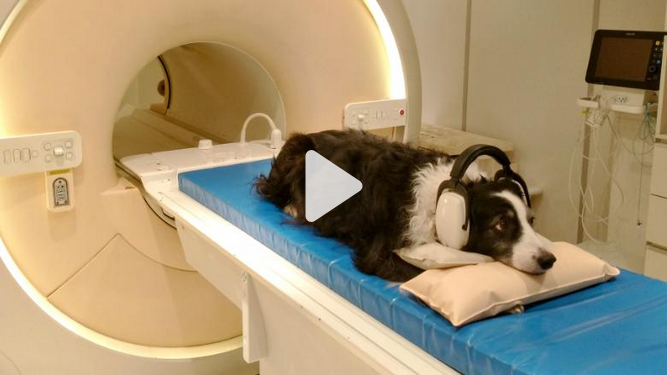–
Now, while working from home and spending more time with our pets, perhaps we’ve reached a form of understanding that crosses the linguistic barrier.
There are times when you just know your pet is trying to say something — like when my cat wants to eat something different or listen to the dulcet tones of a British period drama (she prefers “Downton Abbey”).
But even more fascinating is the idea that we’re not entirely different — that we share things in common, some of which used to be considered strictly human qualities. By recognizing our own traits in animals, we can understand them better.
–
Fantastic creatures
 Researchers placed headphones on dogs to see how the canine brain responded to different languages.
Researchers placed headphones on dogs to see how the canine brain responded to different languages.
–
Imagine lying down with headphones on, the words of “The Little Prince” floating through your ears. Then, the words are repeated in an unfamiliar language, followed by nonsense words. You’re in an MRI machine, and inside your head, your brain is lighting up in response to the familiar and the unfamiliar. Oh, and you’re a dog.
When neuroethologist Laura Cuaya moved from México to Hungary with her border collie, Kun-kun, she was driven to discover whether he could detect the language difference.
The result: Cuaya’s study of 18 dogs, monitored inside fMRIs, demonstrated that the canine brain indeed recognized these changes.
–
Dig this
Australia is full of arid deserts now, but millions of years ago it supported thriving rainforests — and they were filled with myriad creatures.
A newly discovered site in New South Wales acts like a time capsule for a period between 11 million and 16 million years ago, which can help researchers fill gaps about “Australia’s origin story.”
–
Trailblazers
 Kristine Bohmann, an associate professor at the University of Copenhagen, collects air samples.
Kristine Bohmann, an associate professor at the University of Copenhagen, collects air samples.
–
Pulling something out of thin air may seem like a magic trick, but researchers have been able to successfully collect and analyze the airborne DNA of animals.
This groundbreaking technique could change the way that endangered species and natural ecosystems are studied and protected.
Two independent groups of researchers tested out different ways of collecting eDNA, or the genetic material released by waste, bodily fluids, and skin or fur, at two different zoos.
–
Force of nature
Last year, we saw a multitude of ways that global weather is intensifying and changing in response to the climate crisis.
Now, researchers are pointing to an extreme new example: a drastic surge in wild weather at the North Pole.
A network of sensors detected a significant increase in lightning in the far northern Arctic — and in 2021 alone, the North Pole experienced twice as many strikes as the previous nine years combined.
–
Across the universe
 This artist’s impression shows a red supergiant star expelling gas in the final year of its life.
This artist’s impression shows a red supergiant star expelling gas in the final year of its life.
–
In a first, astronomers have witnessed the death throes of a colossal star and its eventual demise in the form of a supernova — all in real time.
The red supergiant, located 120 million light-years away from Earth, was 10 times more massive than the sun before it exploded.
Giants like this one were expected to be fairly quiet before reaching an explosive end. But researchers using ground-based telescopes saw the violent expulsion of bright gas from this star in the summer of 2020.
Curiosities
Delve a little deeper:
— See the Flame Nebula’s interstellar clouds in stunning new images taken of the Orion constellation.
— Between 1787 and 1880, more than 100 children were mummified and buried in catacombs at a convent in Sicily. Now, researchers are studying this macabre tourist attraction to find out why.
–
–
–
–
–










